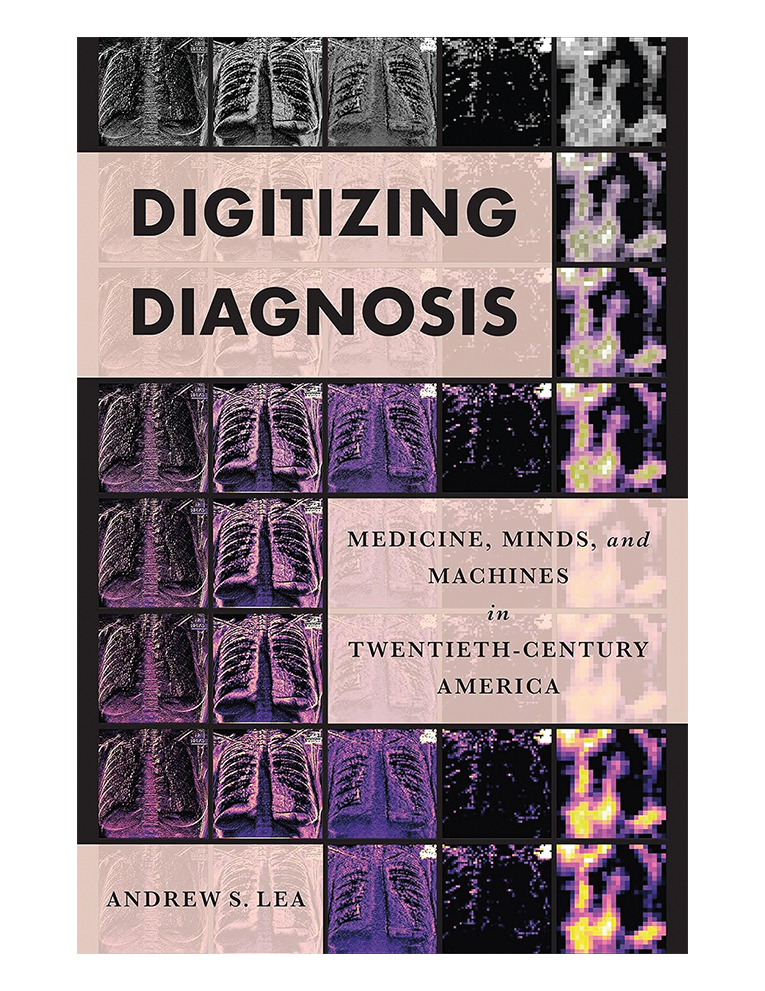Interpretive Crafts

Digitizing Diagnosis: Medicine, Minds, and Machines in Twentieth-Century America
By Andrew Lea ’22, JHU Press
When Andrew Lea ’22 started his residency in internal medicine at Brigham and Women’s Hospital in Boston last year, he brought a historian’s eye to his new job.
With an undergraduate degree in history and science from Harvard and a doctorate in the history of science and medicine from Oxford, Lea carries special insight into clinicians’ debates about how best to use artificial intelligence: He literally wrote a book on the history of computerizing medicine.
Digitizing Diagnosis: Medicine, Minds, and Machines in Twentieth-Century America (JHU Press) explores how the introduction of computers in the 1950s eventually helped to shape medical diagnosis, changing how physicians think about disease, patients and even their own identities.
Lea describes how the creation of the Cornell Medical Index (CMI), one of the first medical questionnaires, previewed this change in the late 1940s. Patients coming into the outpatient departments of New York Hospital would spend roughly 15 minutes answering the index’s nearly 200 questions, a system devised by psychiatrist Keeve Brodman to improve medical history-taking by standardizing it. The CMI eventually reached hundreds of thousands of patients and physicians worldwide.
“The CMI flattened the narratively rich experiences of the patient into a yes/no questionnaire: the patient’s identity was transformed into a pattern of answers on a standardized form,” Lea writes. Out of the CMI grew the Medical Data Screen, “one of the earliest attempts to computerize medical diagnosis and decision-making … [which] converted patients’ answers into the language of statistics, creating ‘the statistical patient.’”
On Feb. 8, 1958, a headline in The New York Times read “Diagnosis by Computer Envisaged for Patients.”
Often, people think of historians as people who are nostalgic about the past. For me, history is an instrument for thinking about how things might be different."
Andrew Lea '22
Digitizing Diagnosis shows how subsequent methods of collecting, managing, reporting and analyzing medical information also brought new questions: How should doctors classify diseases? Could humans understand and trust the opaque decision-making processes of machines? How could computerized systems circumvent, or solidify, bias?
Sound familiar? “It was a conversation that people were having long, long ago that has become even more pertinent in our present moment,” Lea says.
His book points out some shortcomings of such highly anticipated technology as the electronic medical record. Although it was created to decrease the burden of paperwork, the time required for recordkeeping has actually increased.
Lea questions how successfully other cutting-edge technologies will free clinicians to deepen relationships with their patients. “Even if we did have more time as a result of AI taking over various monotonous tasks, I’m skeptical that the excess time would be spent more on each patient as opposed to having doctors see more and more patients,” he says.
After growing up in Richland, Washington, a community associated with the Hanford site where plutonium was produced during World War II, Lea became captivated by the history of science in college. Then, as a graduate student, he realized the similarities between practicing medicine and practicing history when he volunteered in a medical clinic.
“History is an interpretive craft where you sort through different kinds of evidence and craft an argument or narrative about that evidence,” he says. “The same thing is true about medicine. Whenever you’re talking to a patient, you’re getting their narrative, and then you interpret it along with objective evidence from medical imaging or the laboratory.”
He continues: “Often, people think of historians as people who are nostalgic about the past. For me, history is an instrument for thinking about how things might be different. It didn’t have to be the case that we train the way that we do or treat patients the way that we do. Those things are always subject to change, which gives us a more expansive sense of possibility.”
